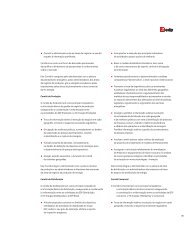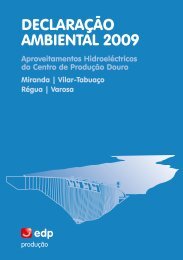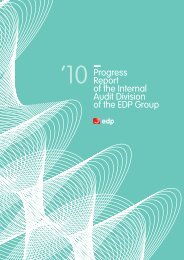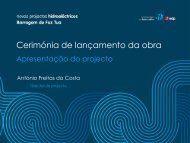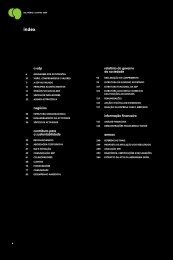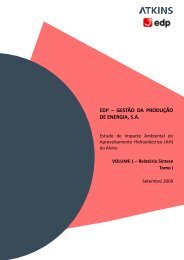Annual Report - EDP
Annual Report - EDP
Annual Report - EDP
- No tags were found...
Create successful ePaper yourself
Turn your PDF publications into a flip-book with our unique Google optimized e-Paper software.
: performance :Fuel oil spillat Aboño power plantIn July 2012, there was an accidentalleak of fuel oil at the Aboño thermalplant owing to a burst pipe in one ofthe plant’s generation units. Despitethe rapid intervention of emergencyteams, which managed to recovermost of the spilt oil, an estimated 10metric tons of fuel reached the seavia the Aboño river. The oil reacheda number of beaches and rocky areason a 13 km stretch of coastline fromCabo Torres to Antromero beach.The accidental marine contaminationemergency plan was activated forthe beach cleaning work and toimplement environmental damageprevention measures. Approximately100 HC Energía employeesvolunteered to take part in the dailyclean-up operations, which werecompleted in a period of roughly15 days, although other recoveryoperations continued.The accident was not classified atthe environmental damage levelbecause it did not result in significantdamage to the natural resources andservices affected, in accordance withthe Legislation on EnvironmentalAccountability.The quality of effluents is regularly monitoredin line with the provisions of the respectiveenvironmental permits and legislation in force.In the specific case of Soto Ribera, the wateris discharged into the River Nalón, which isdeclared a Place of Community Interest, and so theeffluents are bound to comply with temperatureconditions and chemical-physical parameters thatguarantee no change to the recipient environment.This information can be found at www.edp.pt>sustainability> environment. In 2012 there wasa fuel oil spill at the Aboño thermal power plantwhich is briefly described in the highlighted boxon the side).Under the LEAN programme, <strong>EDP</strong> has undertakenlocal initiatives in its generation plants with theaim of reducing consumption and increasingefficiency in the use of this resource.Of particular note in 2012 were:º º Castejon Thermal Power Plant implementeda recirculation system for the extraction of waterand automatisation of the flow control, allowingfor a substantial reduction in the water extracted,effluents produced and chemicals consumed;º º Mortágua Power Plant made improvementsto the electrical circuit and the control aircircuit of the sand filter valves, leading toa reduction in downtime for the raw watertreatment system and also achieving reductionsin water wastage and control air leaks;º º Soporgen Cogeneration Plant upgraded itsdemineralisation plant’s water treatmentsystem, resulting in improved water qualityand a reduction in corrosion of the recoveryboiler and steam turbine pipes.In 2012 <strong>EDP</strong> once again participated in the WaterDisclosure Project survey, being one of the 250companies around the world who did.<strong>EDP</strong> continues to contribute to forums dedicatedto the subject of water, such as the Water WorkGroup of BCSD Portugal, the EU’s European WaterPartnership and the Eurelectric water work group.3.4.5. operationalactivitiesAtmospheric emissionsAtmospheric emissions resulting from combustionto generate electricity are one of the mostsignificant environmental aspects of the <strong>EDP</strong> Groupoperations.TOTAL OF PARTICLES EMISSIONSAT <strong>EDP</strong> GROUP (kt)0.50.50.30.30.40.30.20.6TOTAL OF SO 2EMISSIONS AT <strong>EDP</strong> GROUP (kt)8.28.9PORTUGAL3.3SPAIN6.23.06.43.82009 2010 2011 2012TOTAL OF NO XEMISSIONS AT <strong>EDP</strong> GROUP (kt)21.511.810.97.45.89.34.52009 2010 2011 2012PORTUGALSPAIN12.2Detailed information on the atmospheric emissionsof each plant can be found at www.edp.pt> aboutedp> business units> electricity generation.Waste and by-productsIn Europe, <strong>EDP</strong> has been reporting separatelyon waste and by-products (gypsum, coal fly ashand coal slag in Spain) since 2011, in line with theregulatory changes introduced in 2010.In accordance with the Basel Convention, <strong>EDP</strong>limits the cross-border movement of waste.Export of waste is restricted to PCB waste orsporadic situations, i.e. situations where thecountry in which the waste is produced does nothave the technical capability/facilities requiredfor its disposal. There is no record of any crossbordermovement in 2012.Installations contaminated with PCBsat concentrations below 500 ppm may be keptin operation until the end of their service life, underthe regulations in force. Nevertheless, <strong>EDP</strong>is prioritising the removal of such installationsand equipment under the scope of its replacementplans. In 2012, a total of 118 metric tons containingPCBs were sent for final disposal.11.52009PORTUGAL2010SPAIN20112012This environmental aspect is monitored regularlyin order to verify compliance with the valuesestablished in the legislation and respectiveenvironmental permits.Emissions into the atmosphere increasedsignificantly in 2012 due to a low HPI and tomarket circumstances, which led to an increasein generation using coal-fired thermal powerplants in comparison to similar previous years (forcomplementary information please see page 63).Accident preventionand emergency response<strong>EDP</strong> has procedures in place to identify andrespond to potential accidents preventively,ensuring an adequate response in order toavoid and minimise potential negative impacts.All facilities must have emergency plans andprocedures which identify potential risks, theactions to be taken and the human and materialresources available at the site, and they mustensure that employees or service providers areaware of these practices.There were 295 cases of spills of diverse kindsin 2012, 292 of which were in the distributionactivity. Most of these were the result of acts ofvandalism in power transformers. It is estimated66A World Full Of Energy








